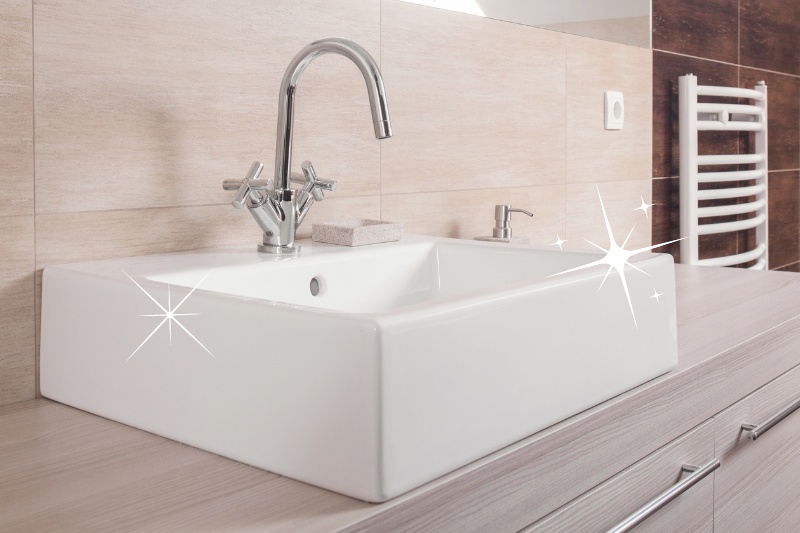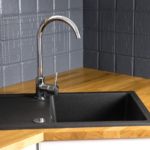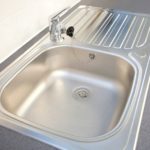Ceramic sinks are durable, mostly stain-resistant, and have a smooth-sleek design. So, it’ll come as no surprise to hear that these sinks are popular in both kitchens and bathrooms!
But, how are you supposed to keep these sinks clean?
It’s actually a lot easier than you think to keep these low maintenance sinks looking like new. Read on to find out how to maintain your ceramic sink.
Follow the steps below to find out how to clean a ceramic sink. Along the way you’ll also learn about what products you should never use to wash these types of sinks!
Tips to Keep in Mind When Cleaning Ceramic Sinks

Here are a few pointers to think about when you’re cleaning a ceramic sink:
- Clean your sink often, so gunk doesn’t build up! Also, cleaning your sink on a regular basis keeps it more hygienic for you.
- Use microfibre cloths to clean the sink – they’re soft enough and won’t damage the ceramic surface.
- Treat limescale on a regular basis, particularly if you live in a hard water area.
- Rinse the sink out when you’re done cleaning it – this’ll remove any excess cleaning product!
- Make sure whatever cleaning product you choose to use is suitable for ceramic surfaces!
- It’s not recommended to pop a plastic washing up bowl inside a ceramic sink. This is because grit and grime usually collects at the base of the bowl, and this debris can scratch the ceramic surface. But if you are set on using a plastic washing up bowl, make sure you clean its base frequently.
- You may have to repeat some treatments more than once, particularly if you’ve got large mineral deposits built up!
Things to Avoid when Cleaning Ceramic Sinks

Although ceramic sinks are known for their durability, there are some products and tools you should never use to clean the surface. If you were to use any of the items listed below you’d risk damaging your sink, and it could also lose its softness and shininess. Avoid using the following:
- Bleach
- Scouring pads
- Concentrated drain cleaners
- Caustic soda
- Scouring powders – they can be too abrasive
- Wire brushes
- Ammonia
How to Clean a Ceramic Sink
Below you’ll find a step-by-step guide to cleaning a ceramic sink on a daily, weekly, and monthly basis. Continuously maintaining your sink, as well as using it well, will ensure its longevity.
Daily cleaning
It’s worth giving your ceramic sink a quick clean every day, so it looks fresh, is hygienic, and more importantly, you’ll stop the build up of gunk!
If you’re doing a daily clean, you really don’t need to use heavy duty cleaners, a bit of soap and water will do the job! Follow either of the methods below.
Option 1: Washing up liquid and water (easiest method!)
Tools you’ll need:
- Gloves
- Washing up liquid
- Water
- Microfibre cloth
- Soft sponge
Steps to follow:
- Empty your sink out.
- Grab a soft sponge and wet it with some water.
- Drop a blob of washing up liquid onto the sponge.
- Gently start to wipe the entire ceramic surface down with the soapy sponge – use small circular motions.
- Continue to do this until the whole surface has been covered in a soapy film.
- Rinse the sink clean with some fresh water.
- When you’re done, grab a microfibre cloth and buff the ceramic sink dry – use circular motions again.
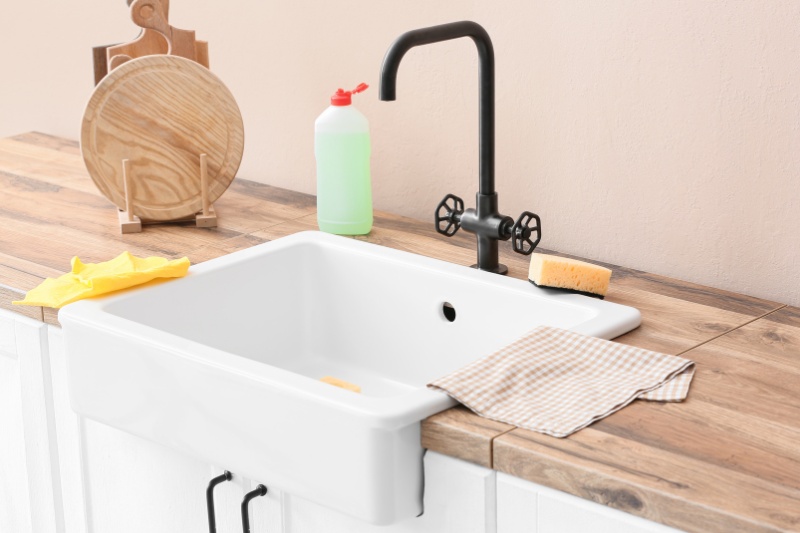
Option 2: Bicarbonate of soda and lemon
Tools you’ll need:
- Gloves
- Water
- Bicarbonate of soda
- Soft sponge/cloth
- Teaspoon
- Four lemons (adjust figure as needed)
- Microfibre cloth
Steps to follow:
- Pop some gloves on.
- Clear out the sink.
- Fill the whole sink up with water – make sure the water doesn’t go over the edge though.
- Soak a soft sponge/cloth in the water, wring it out, and then place it to one side.
- Remove the plug from the sink and allow all of the water to drain away.
- Grab your bicarbonate of soda and sprinkle it all over the sink – use your hands or a teaspoon to do this.
- Take your time completing Step 6 and make sure the whole surface is covered.
- Add a little extra bicarbonate of soda to more grotty areas/stained patches.
- Grab your damp cloth and start to gently rub the sides of the sink.
- Repeat Step 9 until you’ve cleaned the whole ceramic sink – rinse the sponge as you go, so you don’t re-apply the dirt that’s come off.
- Rinse the sink with water when you’re done.
- Grab about four lemons and cut them all in half.
- Pick up one lemon half at a time, and start rubbing it along the walls and bottom of the sink.
- Make sure you squeeze the lemon as you go, so the juice sticks to the surface.
- Repeat Step 13 and 14 until you’ve covered the whole ceramic sink.
- Wait about 30 minutes – the acid in the lemon juice will get to work breaking down pesky stains.
- Rinse your sink with water when you’re done.
- Dry the sink with a microfibre cloth.
Weekly cleaning
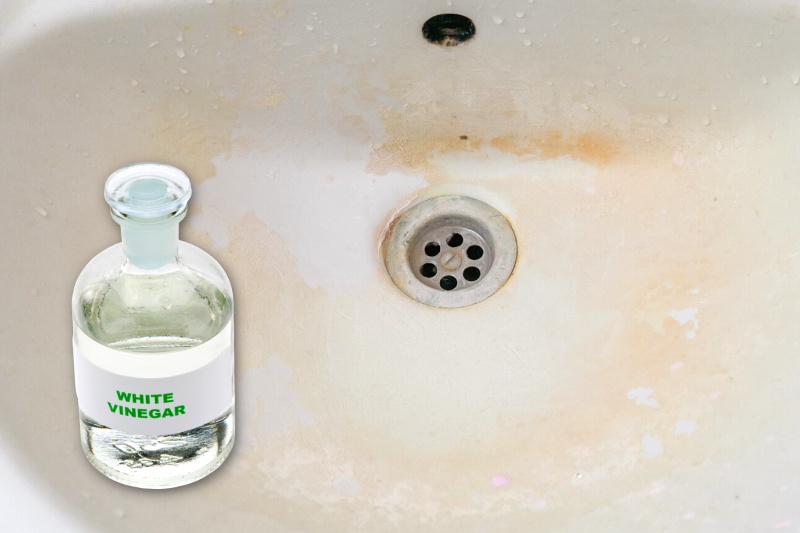
If you’ve kept on top of your daily cleaning, your ceramic sink should be in pretty good condition. So, all you need to do on a weekly basis is remove any limescale deposits that might’ve built up. Follow one of the methods below.
Option 1: White vinegar and water
Tools you’ll need:
- Gloves
- White vinegar
- Water
- Bowl
- Teaspoon
- Microfibre cloths
- Washing up liquid
Steps to follow:
- Fill a bowl up with 50% white vinegar.
- Top the rest of the bowl up with water (50%).
- Give the mixture a quick stir.
- Soak a microfibre cloth in the bowl.
- Wring out the excess liquid.
- Start to rub the walls and bottom of the ceramic sink down with the microfibre cloth.
- Repeat Steps 4 to 6 multiple times, so you clean the limescale away.
- After you’ve cleaned the whole sink, you can rinse it out with water and soap.
- When you’re done you can dry the ceramic sink with a new microfibre cloth.
Option 2: Specialised cleaner
Tools you’ll need:
- Gloves
- A limescale cleaner, like BLANCO DailClean+ or HG Limescale Remover
- A microfibre cloth
Steps to follow:
- Pop some gloves on.
- Clear the sink.
- Apply the limescale cleaner to the affected areas (as per the instructions on the packaging).
- Wait for the product to work (see exact instructions on packaging).
- Rinse and wipe the sink clean with a damp microfibre cloth to remove product residue.
- Optional: Wash the ceramic sink out with water and soap (follow advice on packaging).
- And then use another microfibre cloth to buff and dry the sink.
Deep cleaning
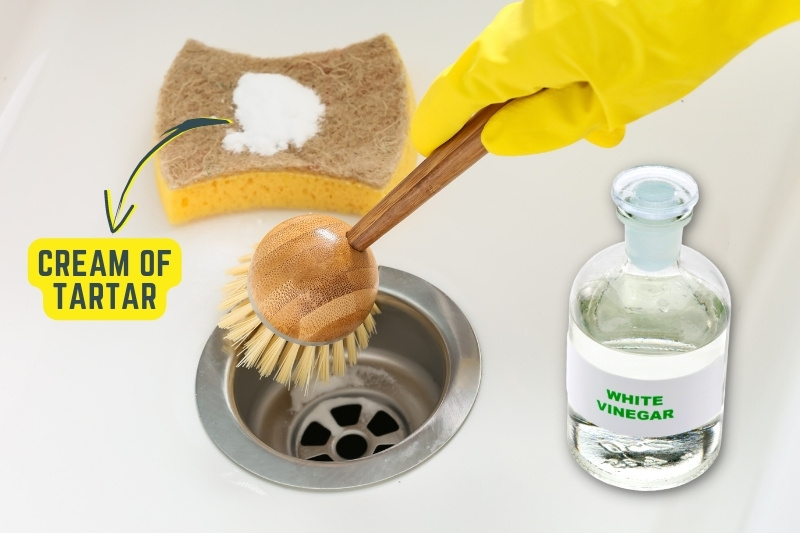
As a rule, if you continuously maintain your ceramic sink, it shouldn’t be that dirty.
However, once a month, or thereabouts, it’s worth giving your ceramic sink a deeper clean. This is to remove any tough mineral deposits and hardened grime that you may have overlooked.
Follow one of the methods outlined below.
Option 1: White vinegar and cream of tartar
Tools you’ll need:
- Gloves
- White vinegar
- Cream of tartar
- Small bowl
- Spoon
- Soft sponge
Steps to follow:
- Pop some gloves on.
- Empty your ceramic sink of dishes.
- In a bowl mix one part white vinegar with one part cream of tartar.
- Stir the ingredients until it thickens up.
- Scoop the mixture out of the bowl and pop it onto the stained areas in your ceramic sink.
- Wait about 10 to 15 minutes.
- Grab a soft sponge, wet it, and wring the water out.
- Clean the white vinegar and cream of tartar mixture off your sink’s surface with the sponge.
- Rinse the sink out with water and soap.
Option 2: Specialised cleaner
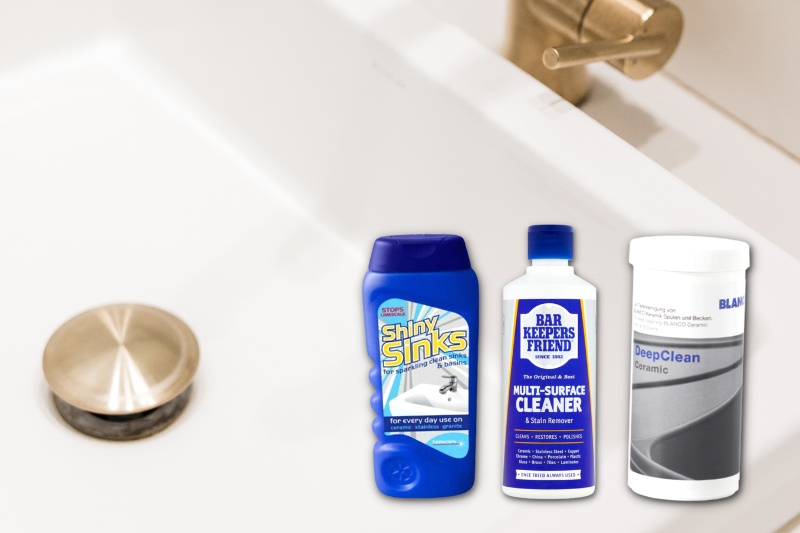
Tools you’ll need:
- Gloves
- A tougher cleaner that is designed to clean ceramic surfaces, like BLANCO Deep Clean Ceramic, Bar Keepers Friend Original or Shiny Sinks Cleaner
- A microfibre cloth/soft sponge
Steps to follow:
- Remove everything from the sink.
- Pop some gloves on.
- Wet your cloth/sponge.
- Wring out the water.
- Add a dose of the cleaner to the damp cloth/sponge (see guidance on packaging).
- Gently and carefully work the solution into the ceramic surface – use circular motions to massage the product in.
- Continue to do this until you’ve cleaned the surface.
- When you’ve done this you can grab a fresh damp cloth and wipe the entire ceramic sink down.
- To make sure the sink is safe, you can clean it with some warm soapy water and a fresh sponge.
- Rub the surface dry and buff it with a fresh and dry microfibre cloth.
How to Clean a Stained White Ceramic Sink
There are multiple ways you can clean a stained white ceramic sink. These include using white vinegar and cream of tartar, or investing in a specialised product. Follow the steps outlined in ‘Deep cleaning’ for an in depth guide on how to remove stains.
How to Clean Ceramic Sink Scratches
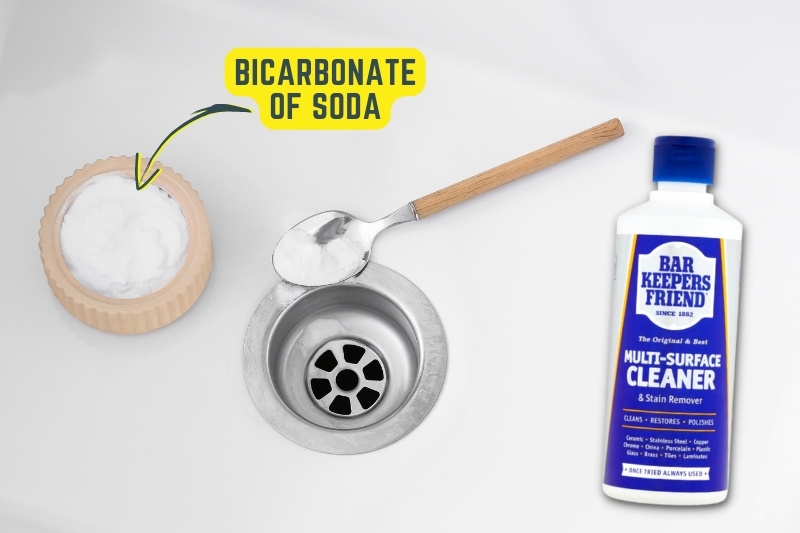
To remove scratches from a ceramic sink, you can either use a chemical free product like bicarbonate of soda. Or you can try to work out the marks with some Bar Keepers Friend Original.
Alternatively, you could try using a Magic Eraser to remove the scratches, but you do so at your own risk. If you are going to try this you must be very careful because you might scratch your sink’s surface even more.
How to Look After a Ceramic Sink
Looking after a ceramic sink is fairly straightforward. All you need to do is wipe the sink down every day with soapy water, clean the limescale out of the sink on a weekly basis, and do a deeper clean every month or so.
Generally speaking, if you keep on top of the sink cleaning, these daily/weekly/monthly jobs won’t take you too long to complete.
The key is to make a habit of washing your sink, so it doesn’t end up in a mess. A sink that’s full of grime and limescale is going to take an age to clean. So don’t let your ceramic sink get into this state.
In addition to cleaning your ceramic sink, you can also take care of your sink by treating it well. So, don’t drop plates into it, don’t scratch it with scourers, and don’t fill it with chemical-ridden products! If you look after your sink, it’ll stick around for a long time.
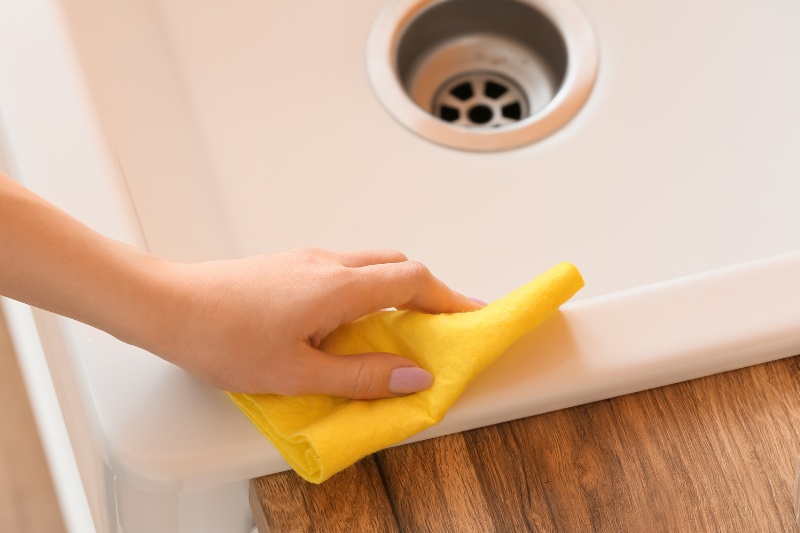
Can I Use a Magic Eraser On a Ceramic Sink?
You can use a magic eraser on a ceramic sink, but you do so at your own risk. These types of erasers can be used to treat scuffs and scratches, as well as removing some stains.
However, you do run the risk of marking the sink because the eraser has an abrasive sort of nature. So, don’t scrub your ceramic sink too vigorously if you are going to try this. Just be very gentle!

Bethan has a passion for exploring, reading, cooking and gardening! When she’s not creating culinary delights for her family, she’s concocting potions to keep her house clean!
